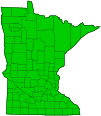American stinging nettle
(Urtica gracilis ssp. gracilis)
Conservation • Wetland • Description • Habitat • Ecology • Use • Distribution • Taxonomy
Description |
||
American stinging nettle is a 18″ to 72″ tall, erect, perennial forb that rises from a long rhizome. It often forms large colonies or dense patches. The stems are erect, stout, unbranched, and 4-angled. They are hairless or have straight, stiff, sharp, appressed hairs, with a few stinging hairs. The leaves are opposite, egg-shaped to lance-shaped, 2⅓″ to 8″ long, and ¾″ to 3″ wide. The blades are rounded, rarely heart-shaped, at the base, and taper to a point at the tip. The upper surface is hairless or has minute, fine, short hairs, but rarely has a few stinging hairs. The lower surface has stinging hairs. The margins are coarsely toothed, the teeth averaging 1 ⁄16″ to ⅛″ deep. The leaves droop downward slightly on ½″ to 2½″ long stalks that have stinging hairs. At the base of each leaf stalk are a pair of 3 ⁄16″ to ⅝″ long, lance-shaped, leaf-like appendages (stipules). The inflorescence is a branched, spreading, elongated cluster drooping downward on a stalk rising from the middle and upper leaf axils. Individual flowers have either male or female reproductive parts, but not both (unisexual). Both male (with stamens) and female (with pistils) flowers are borne on all plants with the female flowers above the male flowers. Male flowers are ascending, ⅛″ wide, with 4 green petal-like sepals and 4 white stamens. There are no petals. Female flowers are loose and bent backward, ⅛″ wide, with 2 inner, egg-shaped sepals enclosing the ovary, and 2 outer, linear, narrowly spoon-shaped, or lance-shaped, petal-like sepals. There are no petals. The fruit is an egg-shaped achene. |
||
Height |
||
18″ to 72″ |
||
Flower Color |
||
Cream |
||
Similar Species |
||
Canadian woodnettle (Laportea canadensis) leaves are alternate and broader. The stem zigzags. Small-spike false nettle (Boehmeria cylindrica) has no stinging hairs. |
||
Habitat |
||
Wet to dry. Disturbed sites. |
||
Ecology |
||
Flowering |
||
June to September |
||
Pests and Diseases |
||
|
||
Defense Mechanisms |
||
The stinging hairs are hollow and act like syringes injecting histamine, acetylcholine, and a neurotoxin. They produce an intense burning and itching sensation. |
||
Use |
||
|
||
Distribution |
||||
|
Sources |
|||
| 6/25/2023 | ||||
Nativity |
||||
Native |
||||
Occurrence |
||||
Common |
||||
Taxonomy |
|||
| Kingdom | Plantae (Plants) | ||
| Division | Tracheophyta (Vascular Plants) | ||
| Subdivision | Spermatophytina (Seed Plants) | ||
| Class | Magnoliopsida (Dicots) | ||
Order |
Rosales (Roses, Elms, Figs, and Allies) | ||
Family |
Urticaceae (nettle) | ||
Genus |
Urtica (nettles) | ||
| Species | Urtica gracilis (slender stinging nettle) | ||
The species Urtica gracilis was formerly treated as the subspecies Urtica dioica ssp. gracilis. Urtica dioica is a problematic species. It is highly variable (polymorphic) in the number of chromosome sets (ploidy level), developmental traits, and chemical composition. It also exhibits variation in its sexual system, including polygamy, several types of gynodioecy, and various architectural types of monoecy. For these reasons, it was treated as the taxonomic group Urtica dioica sensu lato (sensu lato means “in the broad sense”). A recent study of Urtica dioica sensu lato (Henning et al., 2014) concluded that the American taxa, which are monoecious, form a clade that is clearly separate from the western Eurasian and African taxa, which are predominantly polygamous. The two clades also differ in the shape of the achenes and the length of their stolons. The authors advocated placing the American taxa under Urtica gracilis. The recommendation has had a mixed reception. Currently, ITIS, USDA PLANTS, GRIN, Flora of North America, and NatureServe use the name Urtica dioica ssp. gracilis. NCBI, Plants of the World Online, and World Flora Online use the name Urtica gracilis. GBIF lists both Urtica dioica ssp. gracilis and Urtica gracilis without suggesting that one is a synonym for the other. |
|||
Subordinate Taxa |
|||
|
|||
Synonyms |
|||
| Urtica dioica var. gracilis | |||
Common Names |
|||
| American stinging nettle | |||
Glossary
Achene
A dry, one-chambered, single-seeded seed capsule, formed from a single carpel, with the seed attached to the membranous outer layer (wall) only by the seed stalk; the wall, formed entirely from the wall of the superior ovary, does not split open at maturity, but relies on decay or predation to release the contents.
Axil
The upper angle where the leaf stalk meets the stem.
Linear
Long, straight, and narrow, with more or less parallel sides, like a blade of grass.
Rhizome
A horizontal, usually underground stem. It serves as a reproductive structure, producing roots below and shoots above at the nodes.
Sepal
An outer floral leaf, usually green but sometimes colored, at the base of a flower.
Stipule
A small, leaf-like, scale-like, glandular, or rarely spiny appendage found at the base of a leaf stalk, usually occurring in pairs and usually dropping soon.
Visitor Photos |
|||||
Share your photo of this plant. |
|||||
| This button not working for you? Simply email us at info@MinnesotaSeasons.com. Attach one or more photos and, if you like, a caption. |
|||||
|
|||||
MinnesotaSeasons.com Photos |
|||||
Plant |
|||||
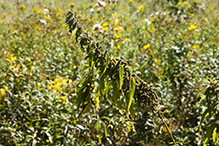 |
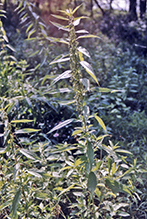 |
||||
Inflorescence |
|||||
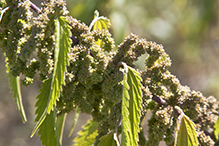 |
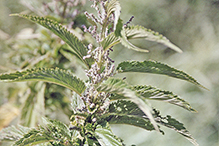 |
||||
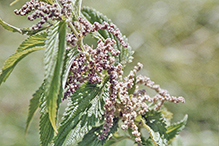 |
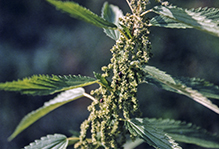 |
||||
 |
|||||

Visitor Videos |
|||
Share your video of this plant. |
|||
| This button not working for you? Simply email us at info@MinnesotaSeasons.com. Attach a video, a YouTube link, or a cloud storage link. |
|||
Other Videos |
|||
| stinging nettle - Urtica dioica Timothy Ross |
|||
About
Published on Apr 27, 2012 'If you touch it you will never forget it" |
|||
| Poisonous Plants 1-2-1, Urtica dioica, the stinging nettle John Robertson |
|||
About
Published on Apr 12, 2014 Some people don't consider the stinging nettle to be a poisonous plant but it is one of the cleverest around. For more information on Urtica dioca please visit http://thepoisongarden.co.uk/atoz/urtica_dioica.htm |
|||
| Common stinging nettle (Urtica Dioica) - 2012-05-13 W3stlander |
|||
About
Published on May 21, 2012 Stinging nettle or common nettle, Urtica dioica, is a herbaceous perennial flowering plant, native to Europe, Asia, northern Africa, and North America, and is the best-known member of the nettle genus Urtica. --------------- |
|||
| Edible wild plants: Stinging nettle - Urtica dioica (Wilderness survival tips and courses) Peak Survival |
|||
About
Uploaded on Sep 10, 2009 Stinging Nettle has a flavour similar to spinach when cooked, and is rich in vitamins A, C, D, iron, potassium, manganese, and calcium. Young plants were harvested by Native Americans and used as a cooked plant in spring when other food plants were scarce. |
|||
| Stinging Nettle Christopher Stokes |
|||
About
Published on Aug 15, 2013 be-careful of this plant if you see it. they sting the skin when touched Stinging nettle or common nettle, Urtica dioica, is a herbaceous perennial flowering plant, native to Europe, Asia, northern Africa, and North America, and is the best-known member of the nettle genus Urtica. The plant has many hollow stinging hairs called trichomes on its leaves and stems, which act like hypodermic needles, injecting histamine and other chemicals that produce a stinging sensation when contacted by humans and other animals. The plant has a long history of use as a medicine and as a food source. Stinging nettle is a dioecious herbaceous perennial, 1 to 2 m (3 to 7 ft) tall in the summer and dying down to the ground in winter. It has widely spreading rhizomes and stolons, which are bright yellow as are the roots. The soft green leaves are 3 to 15 cm (1 to 6 in) long and are borne oppositely on an erect wiry green stem. The leaves have a strongly serrated margin, a cordate base and an acuminate tip with a terminal leaf tooth longer than adjacent laterals. It bears small greenish or brownish numerous flowers in dense axillary inflorescences. The leaves and stems are very hairy with non-stinging hairs and also bear many stinging hairs (trichomes), whose tips come off when touched, transforming the hair into a needle that will inject several chemicals: acetylcholine, histamine, 5-HT (serotonin), moroidin, leukotrienes, and possibly formic acid. This mixture of chemical compounds cause a painful sting or paresthesia from which the species derives its common name, as well as the colloquial names burn nettle, burn weed, burn hazel. The taxonomy of stinging nettles has been confused, and older sources are likely to use a variety of systematic names for these plants. Formerly, more species were recognised than are now accepted. However, there are at least five clear subspecies, some formerly classified as separate species: Other species names formerly accepted as distinct by some authors but now regarded as synonyms of U. dioica include U. breweri, U. californica, U. cardiophylla, U. lyalli, U. major, U. procera, U. serra, U. strigosissima, U. trachycarpa, and U. viridis. Other vernacular names include tall nettle, slender nettle, California nettle, jaggy nettle, burning weed, fire weed and bull nettle (a name shared by Cnidoscolus texanus and Solanum carolinense). Stinging nettles are abundant in northern Europe and much of Asia, usually found in the countryside. It is less widespread in southern Europe and north Africa, where it is restricted by its need for moist soil. In North America it is widely distributed in Canada and the United States, where it is found in every province and state except for Hawaii and also can be found in northernmost Mexico. It grows in abundance in the Pacific Northwest, especially in places where annual rainfall is high. In North America the stinging nettle is far less common than in northern Europe[citation needed]. The European subspecies has been introduced into North America as well as South America. In Europe stinging nettles have a strong association with human habitation and buildings. The presence of nettles may indicate that a building has been long abandoned. Human and animal waste may be responsible for elevated levels of phosphate and nitrogen in the soil, providing an ideal environment for stinging nettles. sharing what i seen today with you. and thank you very much for watching my videos.. |
|||

Visitor Sightings |
|||||
Report a sighting of this plant. |
|||||
| This button not working for you? Simply email us at info@MinnesotaSeasons.com. Be sure to include a location. |
|||||
|
|||||
MinnesotaSeasons.com Sightings |
|||||
Avon Hills Forest SNA, North Unit Bertram Chain of Lakes Regional Park Carpenter St. Croix Valley Nature Center Carver Highlands WMA, South Unit Charles A. Lindbergh State Park Clifton E. French Regional Park Clinton Falls Dwarf Trout Lily SNA Felton Prairie SNA, Shrike Unit Forestville/Mystery Cave State Park Hardscrabble Woods / MG Tusler Sanctuary John Peter Hoffman Spring Brook Valley WMA Lake Alexander Woods SNA, South Unit Mary Schmidt Crawford Woods SNA Minnesota Valley NWR, Black Dog Unit Minnesota Valley NWR, Chaska Unit Minnesota Valley NWR, Long Meadow Lake Unit Minnesota Valley NWR, Louisville Swamp Unit Minnesota Valley NWR, Rapids Lake Unit Minnesota Valley NWR, Wilkie Unit Minnesota Valley State Recreation Area, Lawrence Unit Mound Spring Prairie SNA, North Unit Mound Spring Prairie SNA, South Unit Northern Tallgrass Prairie NWR, Rengstorf Unit P.N. and G.M. Nelson Wildlife Sanctuary Prairie Creek WMA, Koester Prairie Unit Richard M. & Mathilde Rice Elliott SNA Robert Ney Memorial Park Reserve Sand Prairie Wildlife Management and Environmental Education Area Stanley Eddy Memorial Park Reserve Verlyn Marth Memorial Prairie SNA |
|||||

|
Created: Last Updated: © MinnesotaSeasons.com. All rights reserved. |
